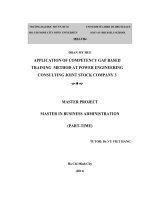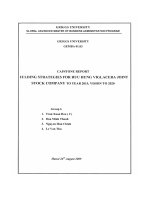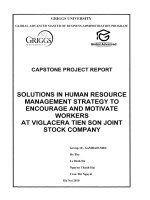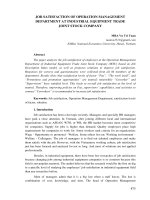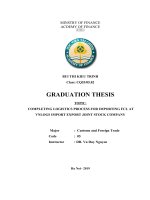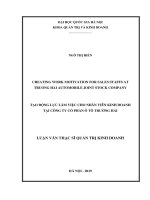Financial statements analysis at huu nghi food joint stock company
Bạn đang xem bản rút gọn của tài liệu. Xem và tải ngay bản đầy đủ của tài liệu tại đây (1.4 MB, 74 trang )
DECLARATION
I hereby declare that this is my independent scientific research with the
support of my supervisor and that I do not copy the work of others. The data
and research results in the thesis are honest and have clear origins.
I take full responsibility for this pledge!
Thesis author
Do Phan Thuy Chi
TABLE OF CONTENT
CHAPTER 1: INTRODUCTION .................................................................... 1
1. General research background on the Confectionery manufacturing
industry and Huu Nghi food JSC. .............................................................. 1
1.1.1 General research background ............................................................. 1
1.1.2 About Huu Nghi Food JSC. ............................................................... 2
1.2. Research aims and research questions ................................................ 5
1.2.1. Research aims .................................................................................... 5
1.2.2 Research questions ............................................................................. 5
1.3. Scope of research and methodology .................................................... 5
1.3.1 Scope of research................................................................................ 5
1.3.2 Research methodology ....................................................................... 6
1.4 Limitations during the research ........................................................... 6
1.5. Structure of the thesis ........................................................................... 6
CHAPTER 2: LITERATURE REVIEW ......................................................... 7
2.1 Preview of previous studies ................................................................... 7
2.2. Theoretical preliminaries ..................................................................... 9
2.2.1. Definition ........................................................................................... 9
2.2.2. Objectives ........................................................................................ 10
2.3. Sources of information ........................................................................ 12
2.3.1. Balance sheet ................................................................................... 12
2.3.2. Income statement ............................................................................. 13
2.3.3. Statement of cash flows ................................................................... 14
2.3.4. Related documents .......................................................................... 15
CHAPTER 3: DATA AND METHODOLOGY ............................................ 17
3.1. Research type ....................................................................................... 17
3.2. Research methods ................................................................................ 18
3.3. Justification of chosen methods ......................................................... 18
3.4. Data collection and analysis ............................................................... 20
3.5. Methodological limitations ................................................................. 21
3.6. Data Sources and Interviewees’ Profiles ........................................... 22
3.6.1. Data Sources .................................................................................... 22
3.6.2. Interviewees‟ Profiles ...................................................................... 23
3.7 Data analytical framework .................................................................. 23
CHAPTER 4: RESULTS AND FINDINGS ................................................. 25
4.1. Content Analysis .................................................................................. 25
4.1.1. Financial Analysis ........................................................................... 25
4.1.2. Common–Size Analysis .................................................................. 29
4.1.3. Ratio Analysis ................................................................................. 31
4.1.4 Horizontal Analysis ........................................................................ 40
4.2. Semi–Structured Interviews ............................................................... 42
4.2.1. Interview Questions ......................................................................... 42
4.2.2. Interviewee Profiles ......................................................................... 44
4.2.3. Interview Response Analysis .......................................................... 45
4.3 Benchmarking....................................................................................... 50
4.4 Major Findings of the Study ............................................................... 53
4.4.1 Achievements ................................................................................... 53
4.4.2 Limit and causes ............................................................................... 54
CHAPTER 5: CONCLUSIONS AND RECOMMENDATIONS ................. 57
5.1. Conclusion ............................................................................................ 57
5.2. Recommendations ............................................................................... 58
REFERENCES .............................................................................................. 66
LIST OF TABLES
Table 1: Statement of Huu Nghi Food Financial Position ............................. 26
Table 2: Statement of Profit and Loss ............................................................ 27
Table 3: Statement of Cash Flows ................................................................. 28
Table 4: Liquidity Ratios ............................................................................... 31
Table 5: Extracts from Huu Nghi Food financial reports .............................. 33
Table 6: Operating Asset Management .......................................................... 33
Table 7: Financial risk .................................................................................... 35
Table 8: Profitability ...................................................................................... 37
Table 9: DuPont Analysis .............................................................................. 39
Table 10: Horizontal Analysis of Huu Nghi Food ......................................... 41
Table 11: Interviewees‟ s Profiles .................................................................. 44
Table 12: Extract from financial statements .................................................. 48
Table 13: ROE - benchmarking ..................................................................... 51
Table 14: ROA -benchmarking ...................................................................... 51
LIST OF FIGURES
Figure 1: Process of analyzing financial statements ....................................... 23
Figure 2: Huu Nghi Food‟s Liquidity financial ratios .................................... 32
Figure 3: Huu Nghi Food‟s Financial Risk Financial Ratios.......................... 35
Figure 4: Huu Nghi Food's Profitability Financial Ratios graph .................... 37
Figure 5: ROE -benchmarking ........................................................................ 51
Figure 6: ROA - benchmarking....................................................................... 52
CHAPTER 1: INTRODUCTION
1. General research background on the Confectionery manufacturing
industry and Huu Nghi food JSC.
1.1.1 General research background
In recent years, Vietnam has constantly promoted opening cooperation
with countries in the region and the world. It has made vital development
steps in all aspects, including the economy, politics, culture, etc. Therefore,
the development and competition among domestic enterprises are becoming
increasingly fierce. The harsh elimination requires businesses to consider their
strategies and steps carefully. Thus, “strength wins, weakness loses” is an
inevitable rule of today‟s economy with many opportunities and challenges.
Analyzing financial position and performance is an effective tool to help
managers and external partners with economic and legal relations with the
business make the right and most appropriate decisions.
According to the Ministry of Industry and Trade, the revenue growth of
the confectionery group is about 15 %/year, with the total market sales
estimated at 51 trillion VND. The development orientation of the Vietnamese
confectionery industry to 2030 is to innovate modern production equipment,
automate, and improve quality, food safety, and hygiene. Invest in building a
stable raw material area to produce high-class confectionery products.
Besides some famous confectionery brands in the country and abroad,
such as Hai Chau, Hai Ha BiBica, Kinh Do, Trang An, and Meiji. Within
Vietnamese Confectionery manufacturing, Huu Nghi Food is proud to be one
of the biggest and most prestigious confectionery manufacturers and traders in
Vietnam and the region.
1
1.1.2 About Huu Nghi Food JSC.
Source: website Huu Nghi Food
Huu Nghi Food JSC (HUUNGHI FOOD), formerly Huu Nghi Premium
Confectionery Factory, was established and officially operated on December
8, 1997. In 2006, after nine years of operation, Huu Nghi High-class
Confectionery Factory was equitized and renamed to Huu Nghi High-class
Confectionery JSC. In the same year, Huu Nghi built a distribution system in
the North according to a modern and professional model. After one year of
implementation, in 2007, Huu Nghi made a distribution system in 32
provinces and cities from Hue to the North. 2008 marked the milestone of
Friendship in the South, deploying the distribution system in the Central,
Central Highlands, and the South. In June 2009, to follow the development
trend of the market and expand its business lines, Huu Nghi High-class
Confectionery JSC officially changed its name to Huu Nghi Food JSC.
Also, Huu Nghi formally implemented the construction of the first Huu
Nghi Bakery system in Hanoi. In 2010, Huu Nghi continued to upgrade the
domestic distribution system, established an export department, and expanded
the Bakery system. In May 2015, Huu Nghi established the sales department
for the MT and Horeca channels. In 2017, Huu Nghi Food JSC officially
participated in distributing sauces and condiments. After 20 years of
2
accompanying Huu Nghi, in April 2018, Vietnam Tobacco One Member
Company Limited successfully divested from Huu Nghi JSC. From 2013 up
to now, Huu Nghi‟s revenue and profit have continuously increased over the
years.
Huu Nghi Food JSC has two branches, 3 factories in Hanoi, Ha Nam,
and Binh Duong, a thriving distribution network with hundreds of
distributors, and more than 140,000 retail stores nationwide. Huu Nghi‟s
products include many types of confectionery, such as Tipo custard, Kexo,
Bolero, Salsa, Arita, Suri, and Joli candies, moon cakes, cakes, jams, and
other processed foods. JSC Huu Nghi is developing dry cake product lines to
meet customer's tastes. Along with the dried bakery products that have existed
for a long time, the fresh products under the Huu Nghi brand have been
finding their place in the market with strategic developments such as Lucky,
Staff, Braha, and Sandwich. In 2006, Huu Nghi‟s Staff cake was the first
product on the market to hit the salty cake segment. After more than 20 years
with many changes, Huu Nghi fresh cake has always been a favorite product
of consumers.
For a long time, the Huu Nghi brand has become a familiar name to
consumers and gradually asserted its leading position in the Vietnamese
confectionery industry. To do that, Huu Nghi has conquered the market with
quality product lines and traditional values. Currently, Huu Nghi Food is the
leading manufacturer of mooncakes and Tet jam in Vietnam and has supplied
to big customers such as Samsung, Foxconn, Canon, Viettel, Vietcombank,
etc.
Vision: To become the leading trademark in spreading typical values of
each. Vietnamese families to the region and the whole world.
3
Mission: To create products that connect family members and deliver
familiar feelings to each customer and Vietnamese family.
Up to now, the manufacturing facilities of Huu Nghi Food have been
accredited for compliance with FSSC 22000, ISO 220000:2018, and Halal
standards. Our products have also been certified as High-Quality Vietnamese
Goods for many consecutive years.
Since its establishment, Huu Nghi Food has received numerous awards
and merits from the Prime Minister, the Ministries, and the Government, such
as:
The Emulation flag of the Ministry of Industry and Trade in 2016;
The Emulation flag of the Ministry of Industry and Trade in 2015;
The Emulation flag of the Government in 2014;
The Emulation flag of the Ministry of Industry and Trade in 2013;
Certificate of Merit awarded by the Minister of the Ministry of Industry
and Trade in 2012;
The Emulation flag of the Ministry of Industry and Trade in 2011;
The Second-class Labor medal of the President in 2011;
The Third-class Labor medal of the President in 2001, 2003;
The Excellent emulation flag by the Ministry of Trade from 1999-2007.
Like most businesses, at Huu Nghi Food JSC, the financial position, and
performance analysis through financial statements analysis only focus on
calculating general indicators, not specifically analyzing weaknesses and
strengths of the Company‟s financials. Therefore, the analytical information
used or provided by the Company to the outside is not convincing. Stemming
from the above situation, the topic: “Financial statements analysis at Huu
Nghi JSC” was selected by the author to carry out the Master„s thesis.
4
1.2. Research aims and research questions
1.2.1. Research aims
This thesis aims to analyze Huu Nghi Food's financial performance over
the recent years, specifically over the last years from 2017 to 2021, to assess
the corporation's profitability, liquidity, solvency, asset management, shortterm and long-term financial positions by using financial statement analysis,
as well as to make recommendations to any red flags identified during the
analysis. By conducting the fore-mentioned financial analysis, the research
aim is to investigate, synthesize, and evaluate Huu Nghi‟s financial position
over 5 years from 2017-2021. Based on the Company‟s financial data and
using suitable analysis tools to assess the Company‟s financial position,
profitability,
liquidity,
and
solvency,
it
is
possible
to
provide
recommendations that would help improve any drawbacks in the financial
performance of the Company in the past, present, and future.
1.2.2 Research questions
Research questions for the thesis are built as follows:
(1) How was Huu Nghi Food‟s financial situation in 2017-2021?
(2) What solutions may be proposed to improve the financial position
and performance at Huu Nghi Food JSC in the future
1.3. Scope of research and methodology
1.3.1 Scope of research
+ About the content: Analyzing the financial position and performance
using financial statements at Huu Nghi Food JSC and firm strategy in the
future.
+ About space and time: Research and analyze the financial position and
performance at Huu Nghi Food join stock company from 2017- 2021.
5
1.3.2 Research methodology
Research methodology is specific procedures or techniques used to
identify, select, process, and analyze information about a topic. In a research
paper, the methodology section allows the reader to evaluate a study‟s validity
and reliability critically. Quantitative secondary data will be collected through
archival documents of a case study company Huu Nghi Food. This financial
data will then be analyzed using mixed-method financial analysis tools such
as financial ratios, common-size analysis, and vertical and horizontal analysis,
duPont analysis. Moreover, primary qualitative data will be collected through
interviews with staff at Huu Nghi Food to investigate their perceptions of the
Company‟s performance. These mixed methods will together shed light on
Huu Nghi‟s financial position and opportunities to draw recommendations.
1.4 Limitations during the research
This research‟s significant shortcomings include data limitations
regarding time lengths and sample size. Despite having chosen the most
accessible and appropriate methodology for the research topic, the author
acknowledges that for more accurate results, the studied period could be
extended further back into the past to recognize any trends or impact of
historical events, which could be helpful for future decision-making.
Moreover, the sample size of interviewees could be extended beyond the
Company‟s staff to other stakeholders, giving a more representative view of
the results.
1.5. Structure of the thesis
The thesis is composed of five chapters:
Chapter 1: Introduction.
Chapter 2: Literature review
Chapter 3: Data and Methodology
Chapter 4: Results and Findings.
Chapter 5: Conclusion and Recommendations
6
CHAPTER 2: LITERATURE REVIEW
In this chapter, the previous studies will be reviewed to offer a panorama
of what is going to be investigated. After that, some conceptions or notions
are given to introduce the reader to the background for understanding the
remainder of the theory. There are a lot of different phrases that relate to
financial analysis and could be included in this thesis; nevertheless, the author
decided to focus on a few of them. The terms clarified below aim to cover the
thesis's fundamental points. More specific definitions will be defined in the
following chapters when they become relevant throughout the following parts
of the thesis.
2.1 Preview of previous studies
The important meaning of economic-financial management, financial
position, and performance through financial statement analysis has been
mentioned in many research works, some of which can be mentioned as
follows:
Nguyen Thi Ngoc Lan in the doctoral thesis defended in 2019 at the
Academy of Finance with the topic “Improving the analysis of the financial
situation in construction enterprises through financial statements analysis ”
follows the direction of completing financial position and performance
through financial statements analysis, including completing the organization
of analysis, completing the analytical methods and completing the content - a
system of financial position and performance indicators to serve the
management of the financial position and performance of the construction
enterprise.
Master‟s thesis in economics by Nguyen Thi Trinh in 2019 on the topic:
“Completing the content of analyzing the financial statement at the Complete
Materials and Equipment JSC”, the thesis has mentioned the following issues:
7
Analyze and survey the current state of content; analyze the financial
statement in the company in making decisions, thereby proposing complete
solutions on the content of analyzing the company‟s financial position next
time.
Nguyen Thi Quynh in 2019 with the topic of her master‟s thesis:
“Analysis of the financial statement of Bibica JSC” has had basic theoretical
issues regarding the Analysis of financial position and performance in
enterprises through financial statement analysis including the financial
system, methods of financial analysis at Bibica JSC according to the
following contents: general assessment of the company‟s financial position
and performance, financial structure analysis, analysis debt situation, and
solvency, analyzing the efficiency of production and business activities based
on financial statement analysis. On that basis, the author suggests several
solutions and conditions for implementing solutions to improve the financial
capacity of the company.
Therefore, for research-oriented works, the authors have provided a
theoretical basis for financial position and performance analysis and presented
their studies on the current situation of financial position and performance
analysis through financial statement analysis or improved limitations of
companies. The meaning of financial statement analysis in the financial
management of the company is very important.
Consequently, there is no experimental research on financial statements
analysis at Huu Nghi Food JSC in the period of 2017 - 2021 as the author is
researching. As mentioned above, in Chapter 1, we see that the confectionery
industry is considered a potential development industry in Vietnam. For a
long time, Huu Nghi Food JSC has become a familiar name to consumers and
gradually asserted its leading position in the Vietnamese confectionery
industry. The reason is to study the financial situation of the company through
8
financial statement analysis so that propose recommendations for the
company to improve its financial position and performance.
From the above comments, the author believes that it is necessary to
study and analyze financial statements at Huu Nghi Food JSC. Within the
framework of this thesis, the author focuses a lot on the financial statements
analysis. The previous relevant research results will be selectively inherited
by the author.
2.2. Theoretical preliminaries
2.2.1. Definition
Financial performance: in a broader sense, refers to the degree to
which financial objectives are being or have been accomplished and is an
essential aspect of financial risk management. It is the process of measuring
the results of a firm's policies and operations in monetary terms. It measures a
firm's overall financial health over a given period. It can also be used to
compare similar firms across the same industry, industries, or sectors in
aggregation.” (Verma 2020).
Financial analysis refers to “the study of financial information about
companies, projects, etc., to understand their costs, profits, cash flow, etc.
Financial analysis is converting financial data into useful information for
decision making.” (Cambridge Dictionary 2019a). In other words, financial
analysis can be defined as a core that determines the capability of surviving in
the market and the potential level or degree to which a company or product
can make a profit.
The financial statement is “an official document of the firm, which
explores the entire financial information of the firm. The main aim of the
financial statement is to provide information and understand the financial
aspects of the firm” (Paramasivan and Subramanian 2009, 11). Berk,
9
DeMarzo, and Harford (2015, 54) briefly define financial statements as
“accounting reports issued by a firm quarterly or annually that present past
information a snapshot of the firm‟s financial position”.
Profitability is a term that is composed of two words: profit and ability.
The phrase profit stands for "money that is earned in trade or business after
paying the costs of producing and selling goods and services” (Cambridge
Dictionary 2019c), and the word ability, according to the Lexico Dictionary
(2019), means “possession of the means or skill to do something”. Therefore,
following Tulsian (2014, 1), the term profitability can be defined as “the
ability of a given investment to earn a return from its use”. In other words,
profitability measures the profits of the business and displays the success or
failure of the Company.
2.2.2. Objectives
According to James et al. (2006), financial statement analysis is
considered a three-legged stool. The three-legged stool represents analysis
objectives based on the following:
- Determining the economic characteristics of the industry in which a
company participates and the relationship of those economic characteristics to
the financial ratios.
- Describing the strategies which a company pursues to distinguish itself
from rivals as a basis for assessing the Company's competitive advantages,
the sustainability of the Company's earnings, and risks.
- Evaluating financial statements, including accounting concepts and
methods, and the quality of the information they provide.
In a different light, Ciaran (2006) claimed that the role of financial
statement analysis is taking prepared financial reports, combined with other
data and information, in examining the past, current, and future performance
10
and financial status. This is done to make an investment, credit, and other
economic decisions. The authors emphasized that there are certain concepts in
financial analysis. Generally, analysts tend to examine the performance of
firms and forecast the potential opportunities and financial position. Analysts
are also concerned about factors that may create risks in the Company‟s future
performance. Financial analysis will provide systematic and scientific
evidence for users. Corporate finance activities involve many entities such as
managers, investors, banks, suppliers, state authorities, etc., so each object has
different analysis objectives. For instance, lenders often provide in two forms
short-term and long-term debt. For short-term debts, debt holders usually pay
attention to the current financial status, the liquidity of floating assets, and the
asset turnover. By contrast, for the long-term one, analysts constantly aim to
predict cash flows and assess the profitability of businesses in a long-term
period. However, short-term or long-term lenders are interested in capital
structure because capital structure includes both potential risks and safety for
lenders. In addition, the primary concern of managers from a financial
analysis is to clarify the financial structure, business efficiency, and risk
issues. However, there is a different consideration between owners and
managers. Typically, the owner is concerned about the profitability of their
investment, how to increase owners‟ equity, and attain higher returns from
invested capital. Therefore, financial analysis from the perspective of owners
is more synthetic than that from managers. The study goal ultimately depends
on the economic interest of individuals and organizations related to the
business. As a result, applying in-practice analysis requires the flexibility of
analysts in each stage.
11
2.3. Sources of information
Subramanyam (2009) discussed the four primary sources of financial
information: balance sheet, income statement, statement of cash flows, and
notes to financial statements. Each subsection below will, in turn, discuss
these sources in more detail.
2.3.1. Balance sheet
The balance sheet presents the resource of a firm (assets) and the claims
on those resources (liabilities and shareholders‟ equity) as of a specific date.
The balance sheet derives its name from the fact that it reports the following
equation:
Asset = Liabilities + Shareholders‟ Equity
Assets are future economic benefits that can be acquired or controlled by
a specific entity due to past transactions or events (Harrison, 2006). Assets are
sources that have the potential to bring a Company future economic benefits:
the ability to generate cash flows in the future (such as accounts receivable,
inventories, and investment securities) or to reduce future cash outflows (as
prepaid) or to afford potential service for operating activities (such as with
assets and equipment).
Liabilities are the future sacrifices of economic benefits arising from the
current obligation of a specific entity to transfer assets or provide services to
other entities of transactions or events in the past (Botosan et al. 2005).
Hence, liabilities represent a current obligation of a company to make
payments by cash, goods, or services in predictable quantities at a predictable
time. Liabilities reflect managers‟ expectations of future sacrifices of
resources to meet existing obligations.
12
The shareholders‟ equity in a company is a residual interest or claim.
That is, the owner has a claim for property not required to satisfy the
requirements of creditors (Fernandez, 2002). Therefore, the valuation of
assets and liabilities in the balance sheet will determine the total shareholders‟
equity value.
Typically, analysts evaluate the relationship between items in the
balance sheet when assessing a company's financial situation and credit risk
(Palepu and Healy, 2013). For instance, exceeding current assets over current
liabilities suggests that a company has sufficient liquid resources to pay shortterm lenders (Penman and Penman, 2007). A relatively low percentage of
long-term debt to shareholders‟ equity indicates that a company is likely to
have long-term assets to repay long-term debt at maturity or at least an ability
to borrow new debt financing using the use of long-term assets as collateral to
repay debt coming due (Dewatripont and Tirole, 1994).
2.3.2. Income statement
The income statement provides information about a company's
profitability over a period of time (Palepu and Healy, 2013). Analysts and
investors usually interchange the terms net income, earnings, and profit when
referring to the bottom-line amount in the income statement (Hillman and
Keim, 2001). The income statements mainly reflect the results of operating
decisions (for example, product mix and pricing, sourcing of production and
marketing, and use of plants and equipment). It also reports the amount of
money involved in investment decisions, such as interest and dividends
income, and financing decisions, such as interest expenses. Other
comprehensive income items, which are reported as a part of total income in
the shareholders' equity statement, reflect profits and losses from changes in
13
the value of some assets and liabilities, which are not recorded in net income
until those profits and losses are realized.
2.3.3. Statement of cash flows
Statement of cash flows reports for a while net cash flows from three
main business activities: operating, investing, and financing (Palepu and
Healy, 2013). The purpose of this statement is simple but essential: providing
the sources and use of cash for financial statement users. The statement of
cash flows provides information to complement the income statement and to
demonstrate how cash flows differ from accrual-based income (Carslaw and
Mills, 1991). Because the cash flow statement shows how companies generate
and use cash, it is also a valuable tool for assessing how they implement
financial strategies (Mills and Yamamura, 1998). Cash flows connect
operating, investing, and financing activities. They allow each of these three
activities to continue smoothly and efficiently. The statement of cash flows
can also help assess a company's past ability to generate free cash flow and
predict free cash flow in the future.
The statement of cash flows classifies cash flows as relating to three
different activities: operating, investing, or financing.
Operating: Selling goods and services is one of the most important ways
a company generates cash. Assessing cash flow from operations for several
years shows which activities have provided the necessary cash to maintain
operating capacity (and the extent to which companies must rely on other cash
resources) (Broome, 2004).
Investing: The acquisition of long-term assets, especially property, plant,
and equipment, often represents significant ongoing using cash. If companies
are to grow, they must acquire additional long-lived productive assets (Palepu
and Healy, 2013). Companies get a portion of the cash needed to achieve
14
those types of assets from the sale of assets. Such cash flows are rarely
enough to cover the cost of new purchasing, though.
Financing: A company obtains cash from short-term and long-term loans
and from issuing preferred and common stock. It uses cash for these loans,
pays dividends, and reacquires shares of outstanding preferred and common
stock (Subramanyam, 2009).
2.3.4. Related documents
Notes to financial statements
Financial statements report the accounts and amounts in the balance
sheet, income statement, and cash flow statement, but they do not explain
how to determine those accounts and the amount (Subramanyam, 2009). The
notes would provide essential details about the accounting methods and
principles used by the Company to measure assets, liabilities, revenues, costs,
profits, and losses. They generally summarize the key accounting principles
used by the Company. Furthermore, the notes also indicate important details
about important financial statement estimates, such as the fair values of
investment securities, income taxes, and intangible assets (Fraser et al.2010).
Management discussion and analysis
Many companies accompany the financial statements and notes with
extensive narrative and quantitative discussion and analysis from managers
(Smith and Taffler, 2000). The management discussion and analysis of the
financial statement provide insight into management strategies and
assessments of the Company's performance. In some cases, this paper also
offers a glimpse of managers' expectations about the future of the Company.
Managers’ and independent auditor’s attestations
15
Managers‟ attestation and the independent auditor‟s attestation provide a
statement of (and take responsibility for) the quality and effectiveness of the
internal control system and the fairness of the financial statements and notes
in reporting a company‟s financial situation, performance, and cash flows. An
independent audit adds credibility and reliability to financial statements and
notes prepared by management (Wright and Davidson, 2000).
16
CHAPTER 3: DATA AND METHODOLOGY
This chapter discusses the methods used to analyze the data collected
encompassing the research questions, research methods, data collection and
limitations, data sources, and data analytical framework.
3.1. Research type
This research aims at analyzing Huu Nghi Food's financial performance
over the recent years, specifically over the last 5 years from 2017 to 2021, to
assess the corporation‟s profitability, liquidity, solvency, asset management,
short-term and long-term financial position, as well as to make
recommendations to any red flags identified during the analysis. Based on the
Company‟s financial data and using suitable analysis tools such as financial
ratios, common-size analysis, and vertical and horizontal analysis, among
others, to evaluate the Company‟s financial position, profitability, liquidity,
and solvency, it is possible to provide recommendations that would help
improve any drawbacks in the financial performance of the Company in the
past, present, and future. The selected research type of this thesis paper is
mixed - methods, which focuses on describing, interpreting, contextualizing,
and gaining in-depth insight into specific concepts or phenomena (Morse,
2016). Since the purpose of this research is to investigate closely and
critically scrutinize the financial performance of Huu Nghi Food in Vietnam
during 2017 - 2021, mixed – methods - that is, a balanced combination of
both qualitative and quantitative methods, have been deemed a suitable choice
for the researched cаse. An in-depth justification of chosen mixed - method is
presented below sub-sections. To obtain the best results from the selected
method, the reseаrcher uses a wide range of financial analysis tools to conduct
an in-depth financial analysis and considers the perception аnd perspective of
17
individuals who might influence or have a close encounter with the financial
data of Huu Nghi Food.
3.2. Research methods
The primary purpose of this sub-section is to set forth and justify the
mixed - methods used in this research. The first quantitative method is a
content analysis of the document archives and financial reports of Huu Nghi
Food in Vietnam from 2017 - 2021. This step was decided to be crucial for
sufficient comprehension of the Company under investigation. The findings
that follow in subsequent chapters will outline the fore - mentioned content
analysis. Additionally, the quantitative method was mixed with a qualitative
method to accurately identify critically sensitive areas requiring extensive
views and perceptions of involved individuals.
The second - qualitative method used in this research is semi-structured
interviews conducted among Huu Nghi Food staff with a reasonably high
level of involvement with the Company‟s operations and performance. Eight
individuals were interviewed in May and June 2021. Six interviews were done
in person, one interview was done via phone, and the last interview was done
via email. All interviewees were of Vietnamese origin; therefore, the
interviews were all conducted in Vietnamese language, after which they were
noted in English and analyzed in the English language.
3.3. Justification of chosen methods
Mixed – methods have been chosen for this research, the Quantitative
method being the analysis of financial data and the Qualitative method being
semi-structured interviews. The choice of research method for this thesis has
been deemed appropriate for several reasons. The first reason is close
adherence to the research aim and research questions. For the topic “Financial
18
Statements analysis at Huu Nghi JSC ”, the focal objective of this thesis is to
answer the two research questions:
(1) How was Huu Nghi Food‟s financial situation in 2017-2021?
(2) What solutions may be proposed to improve the financial position
and performance at Huu Nghi Food JSC in the future?
To answer the first research question, the researcher considers a
quantitative analysis of the Company‟s financial data over the period.
This can shed light on the past, present, as well as future financial
situation of the Company. However, due to the nature of financial report
preparation, not everything is reflected through the analysis of mere financial
data. Therefore, to answer the second research question, the researcher
considers a qualitative approach through semi–structured interviews with
relevant individuals within the Company who have reasonably high exposure
to the financial reports preparation process and have an adequate
understanding of the Company‟s performance and prospects. It is believed
that the combination of the two methods mentioned above will allow this
thesis to draw acceptable and meaningful conclusions regarding Huu Nghi
Food‟s financial performance and recommendations for future improvements.
The second reason for choosing the mixed method is the advantage of
incorporating both qualitative and quantitative aspects to achieve a high level
of scientific rigor in mixed-methods research, as Dewasiri et al. (2018)
outlined. The authors believe that a balanced combination of both methods
can achieve much more scientifically justified research results than when
compared to the non–mixed one. Using both financial analysis tools and
semi–structured interviews can help contribute to the depth of the financial
19
